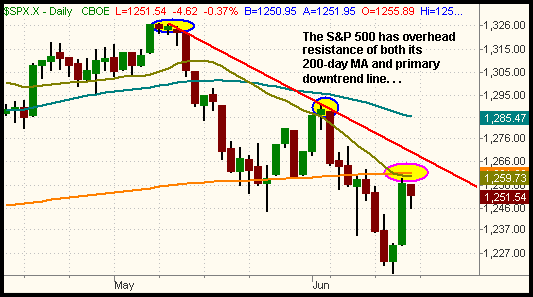Start looking for short sale candidates
The broad market finished the week on a negative
note last Friday, but the major indices still retained most of their gains from
the previous day’s rally. Stocks sold off throughout the morning session,
reversed in the afternoon, but drifted back down in the final thirty minutes of
trading. The Dow Jones Industrial Average was unchanged, but the Nasdaq
Composite fell 0.7% and the S&P 500 lost 0.4%. Small caps lagged behind, as the
Russell 2000 slid 1.1%. The S&P Midcap 400 dropped 0.4%. For the week, the major
indices were mixed. The Dow Jones Industrial Average showed the most relative
strength by gaining 1.1%, but the Nasdaq Composite and S&P 500 closed lower by
0.2% and 0.1% respectively.
Turnover increased in both exchanges last Friday, causing the Nasdaq and S&P to
register another bearish “distribution day.” Total volume in the Nasdaq rose by
9%, while volume in the NYSE was 2% higher than the previous day’s level.
Although volume levels were higher, note that last Friday was “quadruple
witching” options expiration day. The simultaneous quarterly expiration of stock
index futures, stock index options, stock options and single stock futures
typically results in higher volume levels in the market. Nevertheless, it was
negative that a “distribution day” followed the previous session’s “accumulation
day” in the Nasdaq. As you may recall, volume in the NYSE failed to increase on
June 15 despite a 2.1% gain in the S&P 500. Overall, last week’s price action in
the broad market was an improvement over the bearishness of previous week’s but
volume patterns have yet to indicate a clear return of institutional buying.
In the middle of last week, we illustrated the levels at which each of the major
indices would run into resistance of their primary downtrend lines. After the
June 15 rally, several of the indices came within striking distance of those
downtrend lines, but none of them have yet to actually test their resistance
levels. Most likely, we will see that happen this week. Looking at the daily
chart of the Nasdaq Composite, notice how the index remains below its daily
downtrend line:

Like the Nasdaq, the S&P 500 also remains below its primary downtrend line, but
also has additional resistance of its 200-day
moving average
to contend with. This is circled in pink on the chart below:

Although not illustrated on the chart above, the 200-day moving average also
converges with the 38.2%
Fibonacci
retracement level from the May 9 high down to the June 14 low. Based on
recent price action, it will be difficult for the S&P to rally above such a
confluence of resistance, but odds are good that the index will at least probe
above that level on an intraday basis. A powerful wave of institutional
accumulation could enable the S&P to blast through its resistance, but the
market has not yet given us any reason to believe this will actually occur.
Considering the vast amount of technical damage in practically every industry
sector, there simply does not seem to be any impetus for institutions to
suddenly begin heavy buy programs. Remember that it is always wiser to assume
that established trendlines will remain intact until the market proves
otherwise.
Our plan of action as we enter the new week is to view the current rally as both
a chance to sell long positions into strength and initiate new short positions
at low-risk price levels. If the major indices happen to break out above their
downtrend lines, we can quickly cover any new short positions for small losses.
But if the major indices fail the test of their downtrend lines and resume their
six-week downtrends, we will have established short positions at prices that
provide the optimum risk/reward ratio. Presently, we are positioned mostly in
cash and taking a “wait and see” stance over the next few days. Our only open
ETF positions are the Telecom HOLDR
(
TTH |
Quote |
Chart |
News |
PowerRating) and the iShares 20+ year T-Bond
Fund
(
TLT |
Quote |
Chart |
News |
PowerRating), both of which we are long. TTH still has a moderately bullish
chart pattern and continues to show relative strength to the broad market, while
TLT is showing a small loss, but holding above support of its 50-day moving
average. We are also stalking several of the broad-based ETFs for potential
short entries if they fail the June 15 rally attempt, but it may be too soon to
aggressively sell short right now without first seeing the confirmation of the
trend resumption. As always, we will e-mail subscribers of any new ETF positions
that we enter on an intraday basis.
Open ETF positions:
Long TTH and TLT (regular subscribers to
The Wagner Daily receive detailed stop and target prices on open
positions and detailed setup information on new ETF trade entry prices. Intraday
e-mail alerts are also sent as needed.)
Deron Wagner is the head trader of Morpheus Capital Hedge Fund and founder of
Morpheus Trading Group (morpheustrading.com),
which he launched in 2001. Wagner appears on his best-selling video, Sector
Trading Strategies (Marketplace Books, June 2002), and is co-author of both The
Long-Term Day Trader (Career Press, April 2000) and The After-Hours Trader
(McGraw Hill, August 2000). Past television appearances include CNBC, ABC, and
Yahoo! FinanceVision. He is also a frequent guest speaker at various trading and
financial conferences around the world. For a free trial to the full version of
The Wagner Daily or to learn about Deron’s other services, visit
morpheustrading.com or send an e-mail
to deron@morpheustrading.com.
